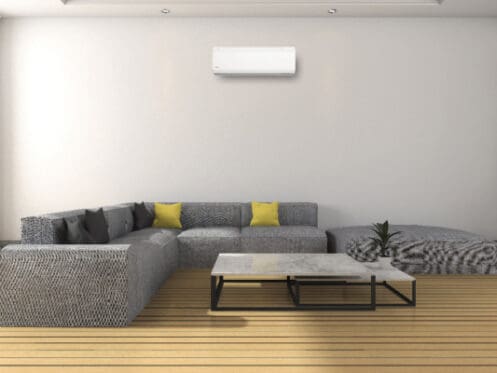Although more homeowners than ever are starting to realize the benefits of ductless mini-split AC systems, they’re still relatively unknown within the US. The reason for that is the fact that conventional central AC systems still dominate the market here. How dominant are they? According to the US Energy Information Administration, an estimated 91% of all new homes built since the year 2000 have ducted HVAC systems. That dominance all but guarantees that American homeowners will know more about central air conditioning systems than they do about ductless mini-splits. To remedy that, here’s a complete explanation of how ductless AC systems work and how they differ from conventional central air conditioning systems.
The Basics of Central AC
Central AC systems are pretty simple to understand. In most cases, they consist of two major components. One is an outdoor unit that houses a compressor and a condenser unit. The other is an indoor unit with evaporator coils and a blower system. A refrigerant loop and some wiring are all that connect the two components. Beyond those things, the only other major part of a central air conditioning system is a network of air ducts running throughout the home.
One series of ducts serves as a path for the central AC to draw warm air from inside the home toward the evaporator coil. There, the warm air passes through the evaporator coil, where the refrigerant absorbs the heat in the air and carries it out of the home. Then, the other series of ducts distribute cooled air to the parts of the home that need it. The whole system relies on a centrally-located thermostat that tells the system when to turn on and off.
For a long time, this was a system that represented the most efficient way to cool a home. Compared to using multiple window air conditioners, central air conditioners consume less electricity while delivering the same volume of cool air.
How Ductless AC Works
Ductless AC systems are, in many ways, a hybrid cooling approach that shares some of the best aspects of window air conditioners and central air conditioning as well. A ductless air conditioning system typically has a single outdoor unit with a compressor and condenser, much like a central AC system. However, instead of relying on a single indoor unit to produce cool air, they have individual air handlers installed in each room that you’d like to cool.
It’s an arrangement that eliminates the need for extensive ductwork running throughout your home. Instead, the outdoor unit connects with each air handler to send and receive refrigerant as needed. And each air handler has its own evaporator coil and blower motor to enable it to cool the room it serves. Plus, each air handler comes equipped with its own thermostat and independent control circuitry.
A Short History of Ductless AC Systems
The design of today’s ductless mini-split air conditioners has roots going back to 1950s Japan when the Mitsubishi company built the first mini-split air conditioning system. They did so because the Japanese homes of the day were far smaller than comparable American homes. Therefore, they lacked the space to install central air conditioners with extensive ductwork. And the proximity of each home to the next made noise an issue as well.
To solve both problems, Mitsubishi designed the first mini-split system with a small, quiet outdoor unit and wall-mounted air handlers for inside the home. Together, the components provided the same cooling power as a central air conditioning system, except with a smaller footprint and far less noise. The design proved popular in Japan, as well as most of the rest of the world outside the US. Today, ductless mini-split air conditioners are the preferred option in most developed countries, with the US being the lone notable exception.
The Advantages of Ductless Air Conditioning
The most obvious advantage of ductless air conditioners is that they’re easy to install just about anywhere. In already-built homes, there’s no need to tear apart finished walls to install ductwork to support one. Instead, most ductless systems need little more than a three-inch hole through each wall with an air handler. That’s plenty of room to run the electrical and control cabling, along with the refrigerant lines to connect with the outdoor unit.
Ease of installation is only the beginning, though. Ductless air conditioners also offer improved efficiency compared to central AC systems. The first reason for that is the lack of ductwork. It turns out that aluminum air ducts are one of the primary sources of energy loss in a central air conditioning system. That’s because they’re affected by the temperature in the walls that surround them and are prone to developing air leaks throughout their lifetime.
The second reason for the improved efficiency is that ductless AC systems offer zoned cooling by default. This means you don’t have to pay to cool rooms you’re not using. Also, you can set different temperatures in each room that you are cooling since each air handler operates independently of the others.
Another advantage of ductless air conditioning systems is that they cool more evenly than central air conditioners. Again, this is due to the inefficiency of in-wall ductwork. In a central air conditioning system, the rooms closest to the central blower often receive colder air and higher airflow than rooms at the ends of each duct branch. As a result, most ducted systems employ damper systems to try and balance their airflow appropriately.
A ductless AC system, by comparison, delivers the exact amount of cooling power required by each room at any given time. Most also feature multiple fan speeds that can more accurately reach the temperature you’ve set. That means there’s no chance of having warm and cold spots inside your home, as you might find with a central AC system.
Trust the Air Conditioning Experts
Now that you’re more familiar with how ductless AC systems compare with central AC systems, you have the right knowledge to choose between the two for your Charleston home. So, if your home’s existing central AC system needs replacement or if you own an older home that lacks existing ductwork, you now know your options. And if you are in the market for a new air conditioning system for your home, the experts here at Charleston Heating and Air would love to help. We’ve served Charleston and the surrounding community since 2009 by offering an array of quality home maintenance services. We offer HVAC installation, repair, and maintenance, in addition to plumbing, electrical, and indoor air quality services. So, if your home has a problem, there’s an excellent chance that we can help you to solve it. Plus, we even offer free estimates on all system replacements, so you don’t ever have to worry about us pressuring you to go forward with any work on your home until you’re ready. So, when you’re ready to choose a new air conditioning system for your Charleston home, contact Charleston Heating and Air right away!

